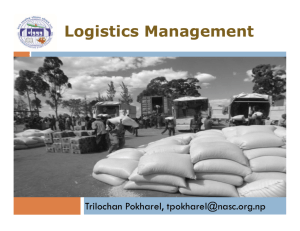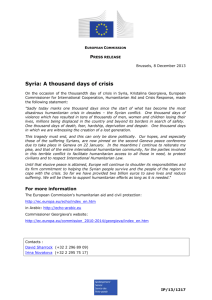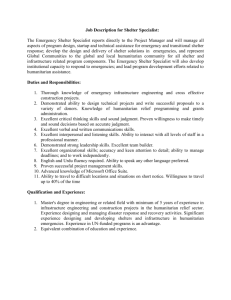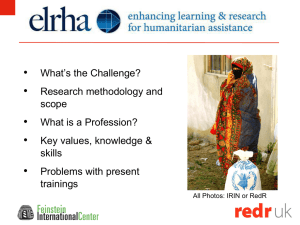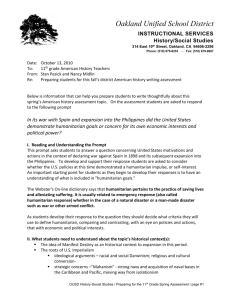Document
advertisement
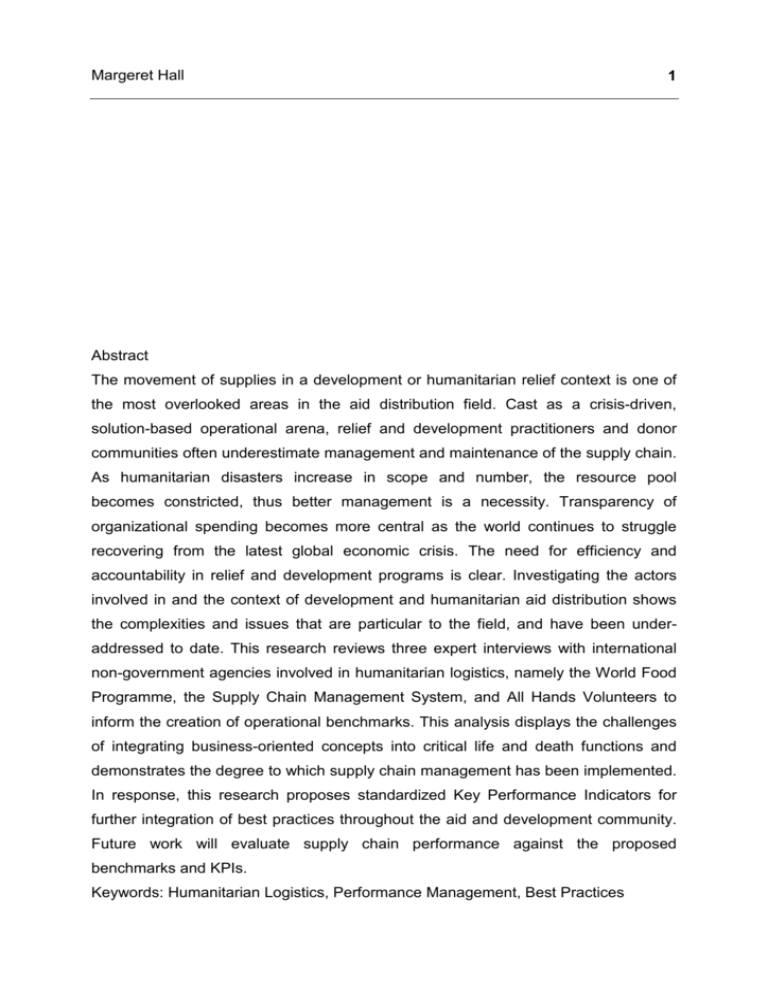
Margeret Hall 1 Abstract The movement of supplies in a development or humanitarian relief context is one of the most overlooked areas in the aid distribution field. Cast as a crisis-driven, solution-based operational arena, relief and development practitioners and donor communities often underestimate management and maintenance of the supply chain. As humanitarian disasters increase in scope and number, the resource pool becomes constricted, thus better management is a necessity. Transparency of organizational spending becomes more central as the world continues to struggle recovering from the latest global economic crisis. The need for efficiency and accountability in relief and development programs is clear. Investigating the actors involved in and the context of development and humanitarian aid distribution shows the complexities and issues that are particular to the field, and have been underaddressed to date. This research reviews three expert interviews with international non-government agencies involved in humanitarian logistics, namely the World Food Programme, the Supply Chain Management System, and All Hands Volunteers to inform the creation of operational benchmarks. This analysis displays the challenges of integrating business-oriented concepts into critical life and death functions and demonstrates the degree to which supply chain management has been implemented. In response, this research proposes standardized Key Performance Indicators for further integration of best practices throughout the aid and development community. Future work will evaluate supply chain performance against the proposed benchmarks and KPIs. Keywords: Humanitarian Logistics, Performance Management, Best Practices “Supply Chain Management in Humanitarian Logistics: 2 Anatomy of Effective Relief and Development Chains“ 1. Introduction Worldwide, people are living in situations characterized by extreme fragility and instability. This comes from both the continuing existence of (extreme) poverty and an ever-increasing amount of disasters, natural and man-made. A quarter of humanity currently copes with malnourishment, illiteracy, and lack of access to an array of domains unknown of in the Western world such as water, sanitation, basic governance, and infrastructure. Yet, with all of the efforts in both development and relief aid, supply chain management, or humanitarian logistics, is consistently underplayed as a necessary and key part of the aid distribution process (Kovács and Spens, 2007; Holguín-Veras et al., 2012; Best, 2013). David Borstein and Tina Rosenberg noted in a series of articles in the New York Times “Delivery and sustainability are slighted because they fall outside the easy-to-measure and easy-toenvision last stage of the solution (Borstein and RosenbergA, 2010).” This is a fatal error; the authors found that due to a single relatively simple upgrade in logistics planning and maintenance, a healthcare distributor in Lesotho was able to increase patient coverage by nearly 600% (Borstein and RosenbergB, 2010). As humanitarian disasters increase in scope and number, resources become scarcer. Better management is a necessity. Improving supply chain management (SCM) mechanisms is one way to achieve increased efficiency and efficacy of international aid and development (Van Wassenhove and Pedraza Martinez, 2012). This review performs a meta-analysis on the applicability of private sector supply chains principles on development and relief logistics. Such an analysis requires a comprehensive research into the origins of humanitarian logistics. Accordingly the paper is structured as follows: the following section “Methodological Framework: Architecting Effective Relief and Development Chain”, the author describes the design methodology; a synergy of standardized best practices, business critical benchmarks, and Key Performance Indicators (KPI). The work then presents and evaluates related literature. In In the section “Benchmarks to create and maintain effective supply chains” a series of measurable benchmarks are introduced. The utilization of these benchmarks in conjunction with KPIs is then described in Margeret Hall 3 “Remapping SCM in the Humanitarian Sector.” In the final section, the author concludes the paper and discusses future work. 2. Methodological Framework: Architecting Effective Relief and Development Chains This theoretical research intends to align commercial sector best practices with current humanitarian logistics practice in a series of organization benchmarks and KPIs. Special attention is paid to competing SCM models and academic discussions, in particular Hau Lee’s Triple-A model (2004). Further eliciting applicable best practices, the results of three Strength, Weakness, Opportunity and Threat (SWOT) analyses with organizational senior leadership from three current humanitarian logistics actors are integrated. The target organizations were the World Food Programme as represented by the Logistics Cluster, the Supply Chain Management System, and All Hands Volunteers. These organizations comprise many aspects of the public humanitarian sector; covering relief, development, non-governmental organizations (NGOs), international organizations, government, and ‘young’ and ‘mature’ programs. With these first-hand expert reports it is possible to find common trends between vastly different portfolios of SCM. Through a compilation of literature and responses to the SWOT, the baseline for this research’s proposed benchmarks are created. Having established the common points of relief and commercial logistics, this research then goes further to suggest performance matrices in the form of KPIs for SCM strategic assessment. 3. Related Work Supply chain management as a holistic management strategy was popularized in the 1990’s, as businesses realized that economies of scale were created by managing the cost, speed and efficiency of warehousing and transportation of goods and services, while simultaneously benefiting from positive customer perception (Basu and Wright, 2008). While this transformation occurred throughout private sector organizations worldwide, logistics deliberations in the public sector loitered behind. Professionalized SCM in the relief and development context remains an ongoing process, in some cases lagging years behind the best corporate practices (Holguín- “Supply Chain Management in Humanitarian Logistics: 4 Anatomy of Effective Relief and Development Chains“ Veras et al., 2012). For the purposes of this work, relief and development chains are subsumed under the term “humanitarian logistics” unless otherwise noted. Demand-side supply chains are complex in any situation; in the development and relief world much more so due to numerous factors like unknown and/or unpredictable events which are varied in size, time, geography, scale and type. Defining supply chain concepts in development related terminology is a first step to better understanding and creating change in the humanitarian sector. Thomas and Rock-Kopczak (2005, 2) define the humanitarian supply chain as: “… the process of planning, implementing and controlling the efficient, costeffective flow and storage of goods and materials, as well as related information, from the point of origin to the point of consumption for the purpose of alleviating the suffering of vulnerable people. [It] encompasses a range of activities, including preparedness, planning, procurement, transport, warehousing, tracking and tracing, and customs clearance.” The key conceptual difference is the clause ‘for the purpose of alleviating the suffering of vulnerable people.’ The vulnerability of the beneficiary community due to either natural or man-made disasters intensifies an already acute urgency, where intensity is calculated as the amount of tasks to be included divided by the time and resources available (Tomasini and Van Wassenhove, 2009). 3.1 Uncharted Territories: SCM theories in the public sector Very little research addressed the possibilities of exporting SCM to the public sector until the end of the 1990’s. Richard Oloruntoba and Richard Gray’s (2006) work on agile supply chains examines business best practices in management and applies them to the humanitarian aid supply chain while recognizing that the elements between the two sectors are similar, though not always transferable. Ron Basu and J. Nevan Wright also expand supply chains to the not-for-profit arena in their book Total Supply Chain Management. Their analysis makes a strong case of publicprivate partnerships, citing the efficiency of corporate suppliers over public suppliers in the post-Hurricane Karina timeframe. Paraphrasing the authors, Wal-Mart was distributing supplies to the disaster-struck regions before the Red Cross or the Margeret Hall 5 Federal Emergency Management Agency (FEMA), namely due to Wal-Mart’s specialization in supply chain and logistics management (2008, 7). Establishing frameworks for evaluation and issue identification were a first attempt at subject-matter crossover. Beamon’s work on relief chains draws this need for identification of the issues and missing pieces of performance measurement (2004). Availability of baseline data is necessary for measurements of performance, but baseline data is often not collected in the aid distribution life cycle due to the urgency of the situation (Beamon, 2004). Anne Davidson (2006) contributed to the debate by assessing and developing KPIs for humanitarian logistics. Davidson’s four KPIs relate to appeal coverage, donation-to-delivery time, financial efficiency, and assessment accuracy. Her focus is mainly on the balance between speed, cost and efficiency of the value chain, representing a traditional approach to SCM. While modest compared to corporate KPIs, this represents a crucial attempt to engrain commercial SCM concepts into the public sector. Stephen Pettit and Anthony Beresford (2009) address the concept of Critical Success Factors (CSFs) in humanitarian aid. While common in successful commercial supply chains, according to the authors this area is ‘poorly addressed’ in humanitarian logistics. Their proposed CSFs are adapted from a review of commercial SCM and include supply chain strategy, strategic planning, inventory management, transport and capacity planning, information management and technology utilization, human resource management, continuous improvement and collaboration. By addressing the missing measurements Beamon, Davidson, and Pettit and Beresford attempt to mainstream commercial concepts into development and humanitarian dialogue. In giving definition to KPIs and CSFs in humanitarian terms, these authors contributed an initial framework by which best practices can be established and exported. 3.2 Business applicability of SCM for the humanitarian sector Supply chain management has been highly monitored and theorized for decades and composes a vast field of literature in economics, engineering, and business. Theoretical frameworks from these fields are meant to be broadly applicable (Stewart, 1997; Stadtler and Kilger, 2008). However, the models that explain the supply chain phenomena and support its management tend to fall short when it comes to detailed processes, especially in humanitarian settings. 6 “Supply Chain Management in Humanitarian Logistics: Anatomy of Effective Relief and Development Chains“ Overriding policy questions on SCM developed in the business world simultaneously. A major debate coalesced around businesses focusing on traditional core competencies, by outsourcing their supply chain component in order to create the best value for money, or investing internal resources in order to maintain in-house control over the entire life cycle. Oliver Williamson’s (2008) article on outsourcing makes the case that outsourcing should be seen from the perspective of transaction costs, and that different types of outsourcing should be utilized at different levels of transaction costs to the organization. This principle is applicable to humanitarian actors assuming a thoroughly vetted partnership is established. The alternative view includes all points of logistics managed within an organization, including reverse logistics capacities; this can include closed-loop supply chains (Dekker et al., 2004). A best practice example of this can be seen in Spanish clothier Zara, which manages all points of procurement, assembly, and transportation to stores worldwide through a single operations and logistics hub in–house. By directing the end-to-end process internally, Zara is able to by-pass some of the most common bottlenecks in supply chain management, including over-stock, stock-outs, and quality/stock controls (Ferdows, Lewis, and Machuca, 2006). These objectives represent a best practice to be implemented in humanitarian logistics. A second debate across the private sector hinges on concepts of efficiency: speed balanced by cost-effectiveness, or agility, adaptability, and alignment. In order to gain market advantage over competitors, companies focused on increasing speed and decreasing delivery costs across the board. This naturally caused management to focus on speed during the boom periods and cost-effectiveness during the bust times. While these balancing points are the hallmarks of traditional SCM, companies focusing on these points were still resorting to mark-downs for stock liquidation, and occasional stock-outs (Lee, 2004). When compared to the giants of supply chain management such as Wal-Mart and Amazon, companies struggle to gain market shares. This led Stanford professor Hau Lee (2004) to theorize a new supply chain triumvirate: supply chains based on agility, adaptability, and alignment. By focusing on these three core competencies, organizations become more responsive, better able to deal with uncertainty, and verify that the interests of all stakeholders are being counted and met. Margeret Hall 7 With regards to SCM modeling, Lee’s Triple A model is most applicable to the public sector. Whereas speed is all-important in humanitarian situations, cost-efficiency is of secondary importance. This is the challenge of utilizing the conceptual framework of speed and cost-efficiency balancing. The gains from exchanging logistics expertise have been shown both by disaster relief efforts from the private sector and by publicprivate partnerships. Benefits derived from public-private partnerships are bidirectional. Private sector logisticians gain from the humanitarians’ experience with risk-laden, dynamic demand-side SCM (Tomasini and Van Wassenhove, 2009). Relief and development professionals not only gain from technical expertise of private sector logisticians, but also from Lee’s concept of alignment. Lee’s model demarcates forward operational standards for humanitarian logistics. 4. Remapping SCM in the Humanitarian Sector: Benchmarks and KPIs to create and maintain effective supply chains Cross-industrial best practices in creating and maintaining an effective humanitarian supply chain have been discussed throughout this research in order to analyze the hallmarks of an efficient humanitarian supply chain. These best practices are established both via the completed meta-analysis and a Strengths Weaknesses Opportunities and Threats interview series completed with the World Food Programme, the Supply Chain Management System, and the volunteer aid group All Hands Volunteers (Stanhope, 2011; Jamieson, 2011; Jilnek, 2011). Insights gained from the interviews form the body of the proposed competitive benchmarks. An overview of the method and suggested processes is found in Figure 1. 8 “Supply Chain Management in Humanitarian Logistics: Anatomy of Effective Relief and Development Chains“ Figure 1. The author’s rendition of Humanitarian Benchmarks for Supply Chain Management Setting criteria allows for standardization in a highly unpredictable field. It also serves to create quality assurance for stakeholders, namely donor and beneficiaries. Table 1’s eight benchmarks should be following with consistency, and applied as a group instead of as an ad hoc improvement mechanism. Implementation of these benchmarks will be a large step forward towards professionalizing the humanitarian supply chain. The target groups are relief and development supply chain departments, inclusive of all strategy, planning, assets, communications packages and systems, procurement and logistics tasks. Margeret Hall 9 Table 1. Humanitarian Benchmarks for Supply Chain Management Identify Critical Success Factors The public sector must define the factors that characterize mission success when providing aid to beneficiaries. Identification of essential factors for core achievements provides mandate clarity, justification for expenditures, and accountability to stakeholders (Pettit and Beresford, 2009). Organizations should adopt an overriding framework that allows for specificity in each relief or development assistance role. CSFs work with the mission statement and mandate to ascertain the activities which must be completed in order to have organizational competitiveness. Demand Forecasting Proper demand forecasting, when combined with warehousing of small, nonperishable items in sensitive locations facilitates agility (Duran et al., 2013; Lee, 2004). This also delivers more finely targeted goods to beneficiaries in a timely manner ahead of the initial post-disaster assessment. SCMS and All Hands Volunteers highlighted the role of product availability as a measure of data availability as a potential weakness (Jamieson, 2011; Jilnek, 2011). Relationship Vetting Creating relationships with suppliers and partners must be in conjunction with a thorough vetting process. In accordance with Lee’s model (2004), there must also always be mutual gain. These factors, along with commitment to humanitarian principles must be considered in contracts. Oxfam’s selective donation base, including donation refusals, is an excellent example of utilizing only suppliers and partners that are committed to social-corporate responsibility (Thomas and Fritz, 2006). The vetting process of WFP includes variables of general organizational dynamics, CSR goals, the effectiveness of the partnership, and value added, representing a best practice when considering partnerships (Stanhope, 2011). Consistency across procurement policies An internal guideline for procuring locally and internationally increases agility, making the value chain more responsive. WFP and SCMS utilize the ‘best value for money’ principle (Stanhope, 2011; Jamieson, 2011). WFP’S P4P procurement program gives a framework to buyers on quality, price and volume requiring standardization across the Procurement group. Deviations from these standards must be reported to Rome headquarters, a mechanism to increase transparency (Stanhope, 2011). WFP noted that localized procurement should and does have different measurement requirements when in place. All Hands Volunteers purchases locally even if supplies aren’t readily available to build the local economy and trust with community members (Jilnek, 2011). Outsourcing Matrix Outsourcing is often useful for non-core activities of development and humanitarian organizations, such as transportation and warehousing, as defined by the CSF exercise. Outsourcing in the public sector implies ability to gauge core competencies of the organization in order to manage the vetting and engagement of suppliers and/or partnerships. Solidly identifying operations which may or may not be outsourced the organization contributes to adaptability (Lee, 2004; Williamson, 2008). Human Resources Newly recruited logisticians must be formally inducted to the organization with a training program for use in the field and at headquarters (Thomas and Rock-Kopczak 2005). A standardized introduction point will also foster working relationships in that colleagues can be assured of baseline knowledge. The further development of professional associations is to be encouraged by senior management, focusing on a crosssection private and public sector professionals. Asynchronous seminars or MOOC technology focusing on post-disaster and development learning should be held annually at a minimum to avoid loss of institutional memory and sponsor the trading of knowledge and best practices (Thomas and Rock-Kopczak 2005). Communications Management Communication in the field and during operations is essential; this is well-known. Communication between disasters, with suppliers and partners, and the communications system delivery tools are equally essential. Clear and established channels of communication are in place with suppliers and partners at all times, and are not ill-maintained between incidents (Stanhope, 2011). Investment (in terms of funding and training) in an Enterprise Resource Planning (ERP), cloud computing and/or data management system facilitates communications management. Performance Assessment Performance assessment remains a major constraint in humanitarian logistics (Jamieson, 2011). Assessing measurement of performance against human lives seems non-calculable. However, achieving transparent efficiency requires continuous assessment loops as proposed in Figure 1 and the KPIs in Appendix 1. 10 “Supply Chain Management in Humanitarian Logistics: Anatomy of Effective Relief and Development Chains“ 4.1 Humanitarian Key Performance Indicators The proposed series of strategic, tactical, and operational KPIs in Appendix 1 are delineated for use in development and/or relief circumstances. While there are distinct features to humanitarian operations that preclude the cost vs. efficiency planning, standards can be adopted and must be rolled out to ensure better use of resources. Humanitarian organizations, like commercial operations, must constantly monitor the success of strategies in place in order to adjust or reevaluate non- or under-producing processes. This proposed series is not exhaustive by design. KPIs are already available for most business processes or can be created within innovation projects. In order to avoid measurement fatigue this assessment series aims to identify and measure only the most pressing processes. The KPIs are not meant to act as a replacement for optimization. KPI assessments are also dynamic; when a metric becomes irrelevant due to innovation or disuse, it should be reformed or replaced. This list is intended to be a living document for export to humanitarian logistics departments, and can and should be updated as necessary. By simplifying and decreasing the number of suggested metrics, and using commonplace data sources when possible, the author creates an easily adapted and adoptable series of performance matrices. These KPIs are simplified for public use; this is done purposefully as to not preclude younger or budget-constrained organizations from adopting the suggested KPIs. 5. Further Research and Conclusion As a whole, continued research focusing on rapid-onset disaster management modeling must be undertaken to have a more complete view of emergency logistics, and the ability and limitations of private sector processes in said circumstances. The next phase of this research will evaluate a young and mature humanitarian operation against the proposed benchmarks and KPIs. While an ex-post metric, this evaluation will prove the strengths and limitations of this approach. A final area of interest is communication and feedback processes of beneficiary communities, as a function of customer relationship management (Jilnek, 2011; Sheppard et al., 2013). Professionalization of public sector logistics contributes to aid effectiveness and transparency with clearer, easily monitored results to donors and faster, high quality Margeret Hall 11 deliveries to beneficiaries. As commercial SCM theories and functions steadily progressed, economies of scale along the entire value chain and higher customer satisfaction are created. This can be seen when looking at companies such as Zara, Wal-Mart and Amazon, which base their corporate strategies on logistics management and have effective market dominance. With roots in corporate sector supply chain management practices and theories, new logistics applications help the humanitarian logistics sector to better respond quickly and flexibly to sudden disasters and changing aid landscapes. This is a positive trend seen in the largest of the aid organizations, and must be continued across the broader humanitarian sector. Overall, standardization is a first step in enabling this fledgling community to better serve stakeholders, the donors and beneficiaries. Applying the best practices from this research by the way of benchmarks and KPIs will map problem areas to increase effectiveness and transparency in humanitarian and development operations. As aid effectiveness is an overarching goal for the humanitarian community, better supply chain management is not only important; it is a necessity. 6. References Basu, R., & Wright, J. N. (2008). Total supply chain management. Routledge. Beamon, B. M. (2004, November). Humanitarian relief chains: issues and challenges. In Proceedings of the 34th International Conference on Computers and Industrial Engineering (pp. 1-6). University of Washington. Best, M. L. (2013). Peacebuilding in a networked world. Communications of the ACM, 56(4), 30-32. Borstein, D., and Rosenberg, T.A (October 22, 2010). FIXES: Beyond Ribbon Cutting, New York Times Online, www.nytimes.com. Borstein, David, and Rosenberg, T.B (October 18, 2010). FIXES: Healthcare and the Art of Motorcycling. New York Times Online, www.nytimes.com. Davidson, A. (2006). Key Performance Indicators in Humanitarian Logistics. Masters diss, Massachusetts Institute of Technology, Engineering Systems Division. Boston: MA. Dekker, R., & Fleischmann, M. (Eds.). (2004). Reverse logistics: quantitative models for closed-loop supply chains. Springer Verlag. 12 “Supply Chain Management in Humanitarian Logistics: Anatomy of Effective Relief and Development Chains“ Duran, S., Ergun, Ö., Keskinocak, P., and Swann, J. L. (2013). Humanitarian logistics: advanced purchasing and pre-positioning of relief items. Handbook of Global Logistics (pp. 447-462). Springer New York. Ferdows, K., Lewis, M. A., & Machuca, J. A. (2004). Rapid-fire fulfillment. Harvard Business Review, 82(11), 104-117. Holguín-Veras, J., Jaller, M., Van Wassenhove, L.N., Pérez, N., Wachtendorf, T. (2012). On the unique features of post-disaster humanitarian logistics, Journal of Operations Management, (30) 7–8, 494-506 Jamieson, D. (7 October 2011). Interviewed by Hall, M. Strengths, Weaknesses, Opportunities, and Weaknesses in the Supply Chain Management System, Hotel Cornavin, Geneva Switzerland. Jilnek, M. (2 November 2011). Interview by Hall, M. Strengths, Weakness, Opportunities, and Threats for the All Hands logistics base in Leogane, Haiti, Telephone interview. Kovács, G., & Spens, K. M. (2007). Humanitarian logistics in disaster relief operations. International Journal of Physical Distribution & Logistics Management, 37(2), 99-114. Lee, H. L. (2004). The triple-A supply chain. Harvard Business Review, 82(10), 102113. Oloruntoba, R., & Gray, R. (2006). Humanitarian aid: an agile supply chain? Supply Chain Management: An International Journal, 11(2), 115-120. Pettit, S., & Beresford, A. (2009). Critical success factors in the context of humanitarian aid supply chains. International Journal of Physical Distribution & Logistics Management, 39(6), 450-468. Sheppard, A., Tatham, P., Fisher, R., Gapp, R. (2013). Humanitarian Logistics: Enhancing the Engagement of Local Populations. Journal of Humanitarian Logistics and Supply Chain Management, (3)1. Stadtler, H., & Kilger, C. (2008). Conclusions and Outlook. Supply Chain Management and Advanced Planning, pp. 497-502. Springer Berlin Heidelberg. Stanhope, A. (20 July 2011). Interview by Hall, M. Strengths, Weaknesses, Opportunities, and Weaknesses in the United Nations Logistics Cluster: World Food Programme, United Nations Office in Geneva. Stewart, G. (1997). Supply-chain operations reference model (SCOR): the first crossindustry framework for integrated supply-chain management. Logistics information management, 10(2), 62-67. Margeret Hall 13 Thomas, A., & Fritz, L. (2006). Disaster relief, inc. Harvard Business Review, 84(11), 114. Thomas, A. & Rock-Kopczak, L. (2005). From Logistics to Supply Chain Management: The Path Forward in the Humanitarian Sector. Fritz Institute San Francisco, 2-15. Tomasini, R. M., & Van Wassenhove, L. N. (2009). Humanitarian logistics. Palgrave Macmillan Limited. Van Wassenhove, L. N. and Pedraza Martinez, A. J. (2012). Using OR to adapt supply chain management best practices to humanitarian logistics. International Transactions in Operational Research, 19: 307–322. 7. Appendix I The overarching strategic concerns in this review have been identified in five areas: delivery, cost, reliability, capacity and information. A total of 15 tactical KPIs are proposed. The KPIs are configured by strategic interest, operational level, and tactical measurements then separated by development and relief value indictors. Targets are closely aligned with industry standards as discovered throughout the meta-analysis.1 Strategic Concern Tactical KPI Operational Metric (relief) Indicator Operational Metric (development) Indicator Adaptability in lead time Hours between Creation of a Reroute Request and the Setting of the Request Status to Closed Hours after emergency request sent (mean, median) Days between Creation of a Reroute Request and the Setting of the Request Status to Closed SLA + # business days (mean, median) Donation to delivery cycle time (goods based) Consignment date goods receipt date Donations available within two weeks (mean, median) Consignment date goods receipt date Donations available within two weeks (mean, median) Percentage (%) of item-referenced goods Supplied Quantity / Ordered Quantity Ratio of PO to nonPO orders % within SLA ∆(actual delivery date – SLA expected delivery date per supplier) % within SLA Delivery Order fill rates On-time delivery 1 # PO and donated items with item reference fulfilling time and quantity expectations of the requester / # PO and donated items with item reference ∆(actual delivery date – SLA expected delivery date per supplier) The formulae were developed via the author’s experience with ERP measurements, then were crossreferenced for applicability and target levels by a field-user and business process expert interviews, and triangulated with an open-source community wiki available from the SAP Users Business Support. To access the wiki, see http://wiki.sdn.sap.com/wiki/display/KPI/Business+KPIs. “Supply Chain Management in Humanitarian Logistics: 14 Anatomy of Effective Relief and Development Chains“ Emergency orders Cost Maverick spend Stockouts Percent of goods on backorder White stocks Reliability Perfect orders fill rate Training Invoice Value without PO and without Contract / Total Invoice Value Product volume on stockout per commodity type / # total product lines per commodity type Volume of product on backorder in the system with firm customer orders / # total orders Volume of earmarked goods per region/ total goods in region # Perfect Orders (Order Fill-Rate * Order Shipping Accuracy * Damage free order % * OnTime Order % * Claim free Order % * Order Entry Accuracy * Order Communication Accuracy * Order Document Accuracy) Outbound / # Orders-Outbound (Days of training per employee + days of training per subcontractor) / year % of total orders have standard shipping % unplanned spend % availability % of backordered goods % availability % of orders with zero errors # learning objectives achieved Working capital Operating Cash Flow (cash earned cash payments) / current liabilities ∆ capital liquidity Turnover rate # Leavers in Department / Headcount of Department % annually Innovation # pilots conducted / # adopted programs % of annual products/services from innovation pipeline Forecast accuracy Volume committed quarterly / volume closed annually % accuracy Capacity Information Inventory marked as urgent freight / total inventory delivered Inventory marked as urgent freight / total inventory delivered Invoice Value without PO and without Contract / Total Invoice Value Product volume on stockout per commodity type / # total product lines per commodity type Volume of product on backorder in the system with firm customer orders / # total orders Volume of earmarked goods per region/ total goods in region # Perfect Orders (Order Fill-Rate * Order Shipping Accuracy * Damage free order % * OnTime Order % * Claim free Order % * Order Entry Accuracy * Order Communication Accuracy * Order Document Accuracy) Outbound / # Orders-Outbound (Days of training per employee + days of training per subcontractor) / year Operating Cash Flow (cash donations - cash payments) / current liabilities # Leavers in Department / Headcount of Department Gross delivery of New Products or Services / Gross delivery Volume committed quarterly / volume closed annually % of total orders have standard shipping % unplanned spend % availability % of backordered goods % availability % of orders with zero errors # learning objectives achieved ∆ capital liquidity % annually % of annual products/services from innovation pipeline % accuracy

